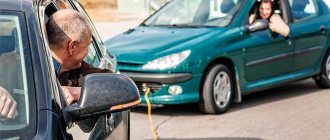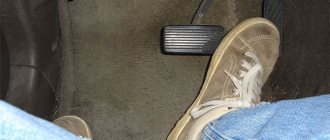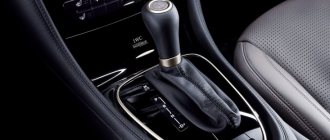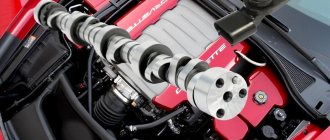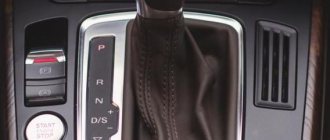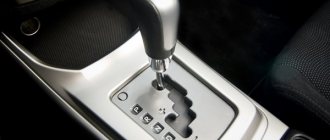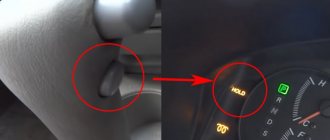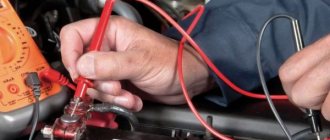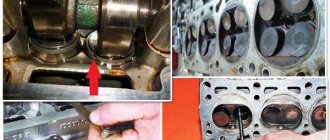Novice car drivers often ask experienced mechanics or car owners whether they need to put the handbrake on a car with an automatic transmission. Controversy has been going on ever since an automatic gear shift device was installed on a vehicle. Automatic transmission manufacturers claim that a parking brake is still needed. It's all about which brake is best to use and what stops the car in the parking lot.
Handbrake in a car with automatic transmission: how it works
The operating principle is the same for all civilian vehicles. By lifting the lever, the drive (mechanical or hydraulic) wedges the pads and locks the wheels.
The transmission of torque, depending on the type of system, can be mechanical - a cable or rigid rod is installed, or hydraulic, similar to the main brake line.
You can learn about the type of device design in a particular car from the service documentation.
Do not use in cold weather or when frost is likely.
When winter sets in, it is highly discouraged to use the handbrake, especially during sudden changes in temperature outside.
Using the mechanism during frost increases the possibility of brake pads freezing to the drums or disc. The result is completely jammed wheels. Then you will have to wait until everything thaws to avoid the mechanism breaking down.
If this happens, you can try using hot water, but this method does not work for everyone. Therefore, it is better not to take risks.
How to correctly put the handbrake on an automatic machine: sequence
It does not matter whether the machine is equipped with a mechanical or hydraulic option - the procedure for use is always identical.
- When stopping in a parking lot or in another place, the automatic transmission is switched to position “P” - parking.
- The engine stops.
- The handbrake lever is lifted.
If the car is equipped with an electronic device, it must be activated before turning off the ignition.
How to use on a hill and a noticeable slope
Be sure to use the handbrake. Instructions for use are described in the paragraph above.
At autostart
It is necessary to comply with the requirements of the factory instructions. The need to use the handbrake will be indicated here. Depending on the design of the unit, this may not be necessary.
Should I put the automatic on the handbrake on a flat surface?
Parking on a horizontal area does not require the use of the element. In such a situation, the load on the automatic transmission locking mechanism is minimal, and the system will independently cope with the load.
In parking mode
When parking, the machine is blocked by a special pin that jams the drive gear. Consequently, in the “P” position, only the drive wheels are fixed.
If conditions suggest the possibility of the car rolling back, it is imperative to use the handbrake.
Is it necessary to undergo a technical inspection?
If provided for by the design of the vehicle, it must be present and functioning properly during inspection.
When the system is damaged, does not work efficiently, or is completely absent, this is a significant reason for refusing to undergo the procedure.
When passing the exam
The inspector will be required to watch the candidate's use of the handbrake. Incorrect use or refusal to use may result in failure of the exam.
What happens if you park your car on a slope all the time?
For many motorists, logic dictates that the automatic transmission mechanism will have to endure the stress of constant parking on a slope. This will cause the pin to fail. The car will roll down.
Attention! Operating manuals for cars with an automatic transmission tell inexperienced car owners not to forget to use the handbrake on slopes or sloping terrain.
And on level parking lots it is advisable to use the parking brake. If another car crashes into a car in a parking lot, left without a handbrake, then not only the bumper, but also the entire automatic transmission will have to be repaired.
Is it possible to pull the handbrake in winter on an automatic transmission?
This is not a good idea, regardless of transmission type.
Typically, the handbrake only blocks the rear axle of the car, and in front-wheel drive versions there is no connection between the systems. From this we can conclude that nothing will happen to the automatic transmission, but the driver must be prepared for a skid. With all-wheel drive or rear-wheel drive versions, everything is more complicated. Jerking the handbrake can cause shock to the transmission and cause damage to it.
Recommendations from experienced car owners and mechanics
Question. The owner of the car still did not understand how to properly use the EPB machine.
Answer . There is no need to overload it by putting the parking brake on the car, even while parking near the store. But you don’t need to let it “rust”.
Question. The car owner does not understand what Hill Start Assist, installed on many modern cars with an automatic transmission, is, and why it is needed.
Answer. Hill Start Assist is a parking brake assist system. It automatically applies the vehicle's rear brake pads when the vehicle stops on a mountain or hillside.
Question . How else can you use the electronic handbrake in cars with an automatic transmission?
Answer . The electronic brake system of the automatic transmission can be used as an emergency brake. If you keep the button pressed, the vehicle automatically starts emergency braking. The only negative is that not all cars are equipped with this advantage.
Question. They say that leaving the parking brake on during maintenance can cause injury. Is it so?
Answer . Yes. The EPB must be switched to service mode when a service station employee is working on repairing the machine or any other part of the car. Unintentionally pressing EPB on an automatic machine can not only harm a person, but also break some parts of the vehicle.
Engine
When talking about what will happen to the car if you drive with the handbrake, we must not forget about such an important element of the system as the engine. The power plant will take on heavy loads when starting off with the wheels locked. The car will shake and the engine will need a lot more power to move. Often, when the handbrake is on, drivers cannot move at all due to the fact that the engine simply cannot pull the load and choke. These are quite serious tests for the motor, so it is better not to allow this to happen. Of course, it is unlikely that the motor will be damaged in this way, but it will definitely be subjected to heavy loads.
Why do brake pads freeze?
This often happens after the pads get wet. So, if the weather is changeable and plus quickly changes to minus, cars often drive through puddles and wet snow. If the water barrier was quite deep, or the car encountered moisture many times a day, it gets into the brake system. When the temperature drops below zero, the parking brake freezes and the brake pads remain pressed against the brake rotor.
In humid air, condensation can also accumulate in the system due to temperature changes. It is deposited on the brake pads and, if parked for a long time in the cold, freezes between the pads and the disc, holding them tightly together.
The situation gets worse if the car is left in the cold for a long time. Especially if during the few days that the car was outdoors there were strong temperature changes and precipitation.
Why should you tighten the handbrake?
The hand brake is a lever connected to the brake pads by a special flexible cable. Let's look at a few points why motorists should use it, even if you have an automatic transmission.
Reliability of car fixation
Even if no external influences arise, know that the bulk of the machine's weight will be on the stopper and gears, and they will wear out faster. You can also damage the mechanical drive of the blocker just for the company. How long it will take for these breakdowns to occur is a debatable question, but it is still better to prevent possible repairs and tighten the handbrake in the parking lot. Keep in mind: to change the stopper, you will have to completely remove the gearbox, open it and change the element.
Purpose of the parking brake device
The parking brake (also called the handbrake or, in short, just the handbrake) is an important element of the braking control of your car. The main system is used directly while driving. But the parking brake works differently: it will hold the car in place if it is parked on a surface that has a slope. It helps make sharp turns in sports cars. Using the handbrake can also be forced: if the main brake system fails, you will use the handbrake to stop the car in an emergency, emergency manner.
This is interesting: How many cubes in gas 53
Use uphill and do not lift on descent
When the handbrake is raised, a light comes on on the instrument panel. Not without reason.
Constantly driving with the handbrake causes overheating of the brake drums or discs when the pads are pressed. In this case, the brake mechanisms will sooner or later become deformed and become completely unusable.
You should try to use the handbrake only if the car is going uphill, and when going downhill, you should not raise the brake. When driving on level terrain, the car must be released from the handbrake.
Stone under the wheel
If there is a need to leave the car on a slope, and the handbrake always works well, then you can play it safe with the help of simple devices.
When parking near a curb, you can turn the wheels so that when you start to roll away, they rest against the curb that restricts movement.
If the car is parked with its nose down, then the steering wheel must be turned to the right. When parking with the stern down and possibly rolling backwards, the wheels are turned to the left so that they also rest against the curb.
If the slopes are so great that the car is literally hanging on the handbrake, and there is no curb stone, then it is better to put some objects under the wheels. They can be a piece of brick, a wooden block, or a specially designed “shoe” with a stop. Such holding “shoes” can fix the car on a slope of 20-30%.
Engine braking doesn't help
On modern cars, the handbrake must always be used. This applies not only to cars with robots that do not have a “P” position in the transmission, but also to cars with manual transmissions, as well as automatic transmissions and CVTs. The design of manual transmissions has changed, and they can no longer be locked while the gear is engaged. When stopping on a slope, with the engine turned off, and the first stage engaged (without using the handbrake), the car begins to slowly and jerkily roll down. Approximately every 12-18 seconds, the wheel rolls back about 1/6 of a revolution, then pauses, and again a new rolling cycle occurs. Even new cars, in which everything is in order with the power unit and transmission, roll down the hill.
The fact is that new turbocharged engines are not designed to support the weight of a 1.2-ton car, which is why they allow the crankshaft to turn under load. However, such a process easily leads to breakdown. A valve mechanism is applied to the shaft through the timing belt, and when rotating, the settings may go wrong, and this, in turn, can damage the valves when starting the engine.
Therefore, it is now impossible to hold cars with manual transmissions using first or reverse gear. Be sure to tighten the handbrake.
Don't panic. How to stop a car with faulty brakes? More details
Engine
When talking about what will happen to the car if you drive with the handbrake, we must not forget about such an important element of the system as the engine. The power plant will take on heavy loads when starting off with the wheels locked. The car will shake and the engine will need a lot more power to move. Often, when the handbrake is on, drivers cannot move at all due to the fact that the engine simply cannot pull the load and choke. These are quite serious tests for the motor, so it is better not to allow this to happen. Of course, it is unlikely that the motor will be damaged in this way, but it will definitely be subjected to heavy loads.
Other elements of the vehicle system are also affected, including suspension, transmission, etc.

